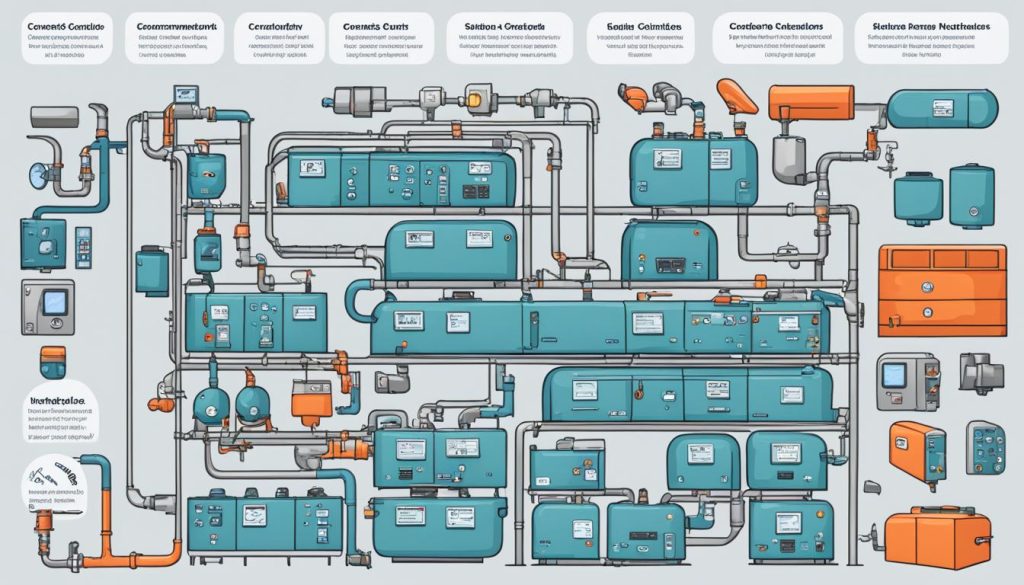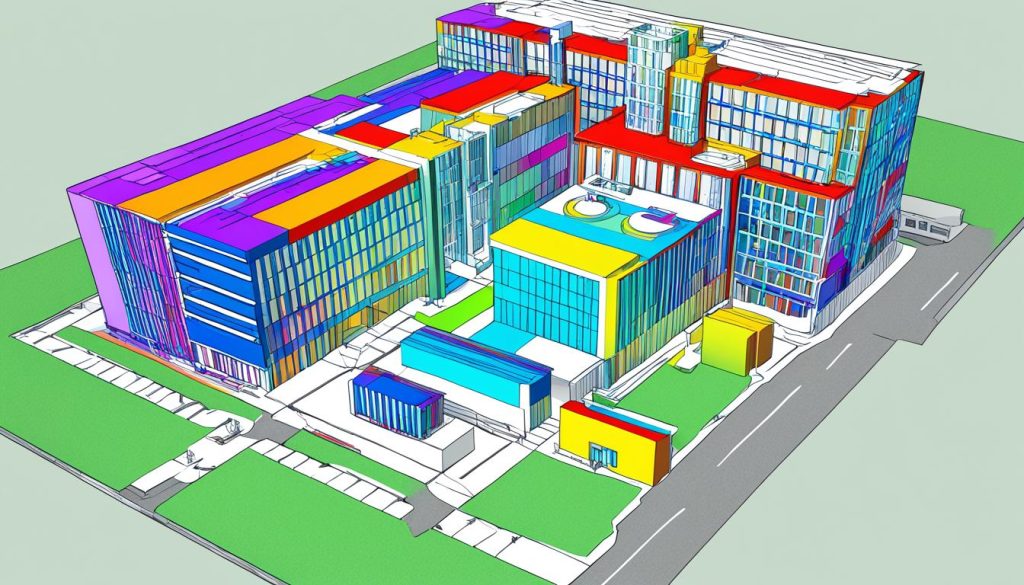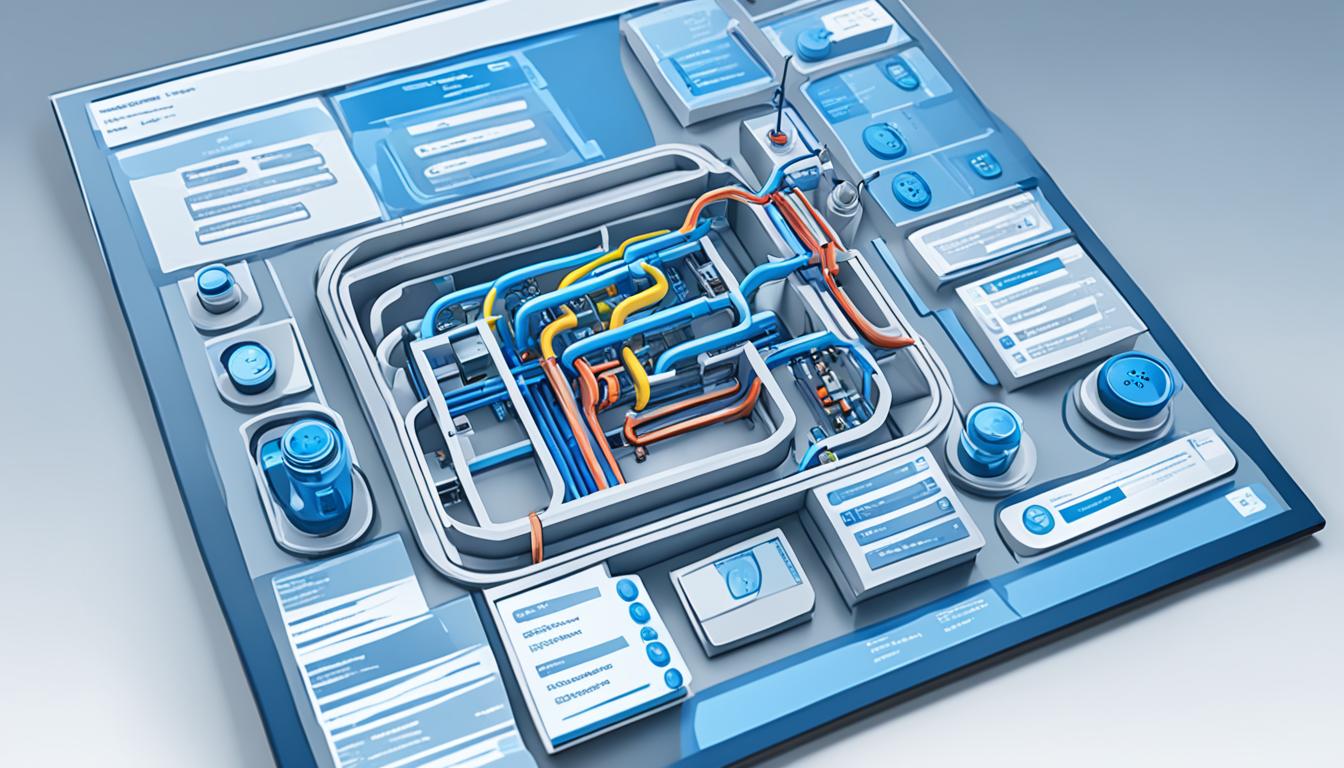CAD HVAC software helps make picking equipment and estimating costs easier in HVAC design projects. It combines computer-aided design with HVAC system features. This makes your work more efficient.
This software lets you make detailed 2D and 3D models of HVAC systems. It automates tasks and helps you work better with your team. You can improve system performance, check energy use, and get accurate cost estimates.
We’ll look at how CAD HVAC software changes the HVAC industry. It makes mechanical engineering better and offers tools for choosing equipment and estimating costs. You’ll see important features, how to pick the right software, and its uses in HVAC design today.
Introduction to CAD HVAC Software
CAD HVAC software changes how we design heating, ventilation, and air conditioning systems. It brings together different parts of HVAC planning, from the first load calculations to detailed layouts.
What is CAD HVAC Software?
CAD HVAC software is a program that mixes computer-aided design with HVAC modeling. It lets engineers and designers make accurate 2D and 3D models of HVAC systems for homes and businesses. This software combines load calculations, energy analysis, and building information modeling (BIM) into one place.
Benefits of Using CAD in HVAC Design
Using CAD for HVAC design has many benefits:
- Improved accuracy in system layouts and load calculations
- Increased efficiency in the design process
- Better visualization of complex HVAC systems
- Easier collaboration among project team members
- Reduced errors and conflicts in the construction phase
Key Features of CAD HVAC Software
Modern CAD HVAC software has key features:
- Detailed 2D and 3D modeling capabilities
- Automated load calculations and system sizing
- Energy analysis tools for optimizing system performance
- Integration with BIM for comprehensive project management
- Libraries of standardized HVAC components and symbols
- Clash detection to identify and resolve conflicts before construction
These features help HVAC professionals work more efficiently, improve design accuracy, and make systems more energy-efficient. Building information modeling also helps with project coordination and data management during construction.
Selecting the Right CAD HVAC Software
Finding the right HVAC design tools can change your project’s game. The best software makes your work easier and more efficient. Let’s look at what to think about when choosing CAD HVAC software and compare top choices.
Comparison of Popular CAD HVAC Tools
Several options are great for HVAC design. Here’s a look at the top ones:
| Software | Key Features | Pricing | User-Friendliness |
|---|---|---|---|
| Fusion 360 | Cloud-based, 3D modeling, simulation | $495/year | High |
| Solidworks | Comprehensive 3D design, analysis tools | $3,995/year | Medium |
| AutoCAD MEP | HVAC-specific features, 2D/3D drafting | $1,775/year | Medium |
Factors to Consider When Choosing Software
What you need in HVAC design software depends on your specific needs. Think about these things:
- User interface and learning curve
- Pricing and licensing options
- HVAC-specific features (e.g., duct sizing, load calculations)
- Compatibility with industry standards
- Customizable workspaces
- Support for legacy DWG drawings
Integration with Existing Systems
It’s key to have software that works well with your current tools. Look for software that:
- Works with BIM software
- Exchanges data easily
- Allows custom integrations
- Supports common file formats
By thinking about these things and comparing options, you’ll find the CAD HVAC software that meets your needs and improves your design process.
Creating Detailed 2D and 3D HVAC Models
CAD HVAC software changes how you make and see HVAC systems. It has strong tools for modeling and 3D visualization. This lets you make your designs come alive in a new way.
When you start with HVAC modeling, CAD software gives you both 2D and 3D options. 2D models are clear and easy to read, showing floor plans. 3D models give you a full view of your system.
In 3D visualization, you can turn, zoom, and move around your model. This is great for finding problems early in the design. You can see if ductwork clashes with other parts, making installation smoother later.
Designing ducts is easy with CAD HVAC software. You can change sizes, directions, and layouts easily. The software also figures out airflow and pressure drops, helping you make your system work better.
| Feature | 2D Modeling | 3D Modeling |
|---|---|---|
| View Type | Plan view | Isometric view |
| Detail Level | Basic layout | Comprehensive system visualization |
| Use Case | Quick drafting and planning | Detailed design and clash detection |
| Editing Ease | Simple modifications | Complex adjustments and rotations |
With these tools, you can make HVAC models that are very detailed and accurate. This precision in your designs means more efficient systems, fewer mistakes during installation, and happier clients.
Automating Repetitive Tasks in HVAC Design
CAD HVAC software changes the game by automating tasks. It makes repetitive tasks faster, saving time and cutting down on mistakes. Let’s dive into how this tech boosts HVAC design productivity.
Creating Libraries of Standardized HVAC Symbols
Make your own HVAC symbol library to speed up design work. These libraries let you use the same parts over and over in different projects. You can make custom symbols for things like equipment, ducts, and pipes, keeping your designs consistent.

Batch Editing and Updating Drawings
CAD HVAC software lets you work on many drawings at once. This is super useful when you’re making changes across a whole project. You can update specs, change sizes, or alter parts in all drawings with just a few clicks.
Automated Calculations and Sizing
Use automated calculations to get things right faster and save time. The software can figure out the right sizes for ducts, pipes, and equipment based on what you tell it. It can also adjust register sizes to keep airflow just right, ensuring the system works perfectly.
| Automation Feature | Benefit |
|---|---|
| Symbol Libraries | Faster drafting, consistent designs |
| Batch Editing | Quick project-wide updates |
| Automated Sizing | Accurate calculations, time savings |
Using these automation tools will greatly improve your HVAC design work. With standard symbols, efficient editing tools, and automated calculations, you get better design efficiency and more precise results.
Facilitating Collaboration in HVAC Projects
CAD HVAC software changes how we work together in the HVAC field. It makes our workflows smoother and helps us talk better with each other. Let’s see how this tech boosts teamwork and makes things more efficient.
Sharing files is easy with CAD HVAC software. Architects, engineers, and contractors can swap design files without trouble. This keeps everyone on the same page, cutting down on mistakes and mix-ups.
Tools for commenting in the software make talking with each other better. Team members can give feedback right on the design files. This quick chat helps make decisions faster and spots problems early, making projects run smoother.
- Access the most recent design files anytime
- Provide instant feedback using built-in commenting tools
- Suggest changes without lengthy email chains
- Resolve potential issues before they become problems
Many CAD HVAC tools work with different file types, making it easier to work together. This means everyone can share info smoothly, no matter what software they use. You can focus on making great designs without getting stuck on tech stuff.
| Collaboration Feature | Benefit |
|---|---|
| Real-time file sharing | Ensures all team members work with up-to-date information |
| In-software commenting | Speeds up feedback and revision processes |
| Multi-format support | Enables seamless communication across different platforms |
Using these tools, projects run smoother and teams work better. CAD HVAC software makes complex HVAC designs work together well and efficiently.
Energy-Efficient Design Planning with CAD HVAC Software
CAD HVAC software changes the game in energy-efficient design planning. It lets you make sustainable and cost-saving HVAC solutions with advanced tools. Let’s dive into how this tech boosts thermal comfort and system efficiency.
Analyzing Airflow Patterns and Thermal Comfort
CAD HVAC software is great at thermal analysis. It lets you see airflow patterns and temperature spreads. You can test different setups to make sure people stay comfortable.
The software spots hot spots, cold drafts, and areas with still air. This helps you tweak your design for the best efficiency.

Optimizing System Performance
System optimization is a big deal with CAD HVAC software. You can tweak your HVAC design by changing duct sizes, where you put equipment, and control strategies. The software shows how these changes affect performance.
This helps you find the sweet spot between comfort and saving energy.
Evaluating Energy Consumption
Checking energy use is key for green design. CAD HVAC software has tools to figure out and look at energy use based on your design. You can compare different setups, see how saving energy helps, and make smart choices to cut costs.
| Feature | Benefit | Impact on Energy Efficiency |
|---|---|---|
| Airflow Analysis | Improved thermal comfort | 15-20% reduction in energy waste |
| System Optimization | Enhanced performance | 10-25% increase in overall efficiency |
| Energy Consumption Evaluation | Informed decision-making | Up to 30% reduction in operational costs |
With these strong features, you can make HVAC designs that go beyond energy efficiency standards. CAD HVAC software lets you offer top-notch comfort while cutting down on environmental impact and costs for your clients.
Use CAD HVAC Software for Equipment Selection and Cost Estimation
CAD HVAC software changes how you pick equipment and estimate costs for projects. It makes the process smoother, ensuring your HVAC designs are accurate and efficient.
Accurate sizing of HVAC components
Getting the right size for HVAC parts is key for good system performance. CAD HVAC software uses advanced algorithms to figure out the exact sizes you need. Just enter the room’s details, insulation, and local climate to get the right sizes for air handlers, ducts, and more.
Generating detailed bills of materials
Creating a detailed list of materials is easy with CAD HVAC software. As you design, the software automatically lists all the parts you’ll need, including how many and what they’re for. This saves time and cuts down on mistakes in ordering, making sure you have everything for your project.
Integrating cost data for precise estimates
Estimating costs is more precise and efficient with CAD HVAC software. It uses up-to-date pricing to give you detailed estimates for materials and labor. Some software lets you add custom parts with their costs, giving you a precise estimate for your project.
| Feature | Benefit |
|---|---|
| Automated equipment sizing | Ensures optimal system performance |
| Detailed bill of materials | Reduces errors in ordering and inventory management |
| Integrated cost data | Provides accurate project cost estimates |
Using these features, you can make your HVAC design process smoother, more accurate, and more efficient. CAD HVAC software helps you make smart choices and deliver top-quality results to your clients.
Leveraging Building Information Modeling (BIM) in HVAC Design
Building Information Modeling (BIM) is changing the game in HVAC design. It combines with CAD HVAC software to make your work flow better and projects more successful. BIM helps manage data well, from the start to the end of a project.
BIM lets you make a digital copy of your HVAC system. This model has all the info on the system’s parts, how they work, and how they connect with other parts of the building. This makes it easier to coordinate HVAC with other systems, cutting down on mistakes and boosting efficiency.
Planning for the life of a project gets simpler with BIM. You can see how HVAC parts will do over time, predict when they need maintenance, and plan for upgrades. This helps with managing the building over the years and saves energy.
| BIM Integration Benefits | Impact on HVAC Design |
|---|---|
| Improved clash detection | Reduces on-site conflicts and rework |
| Enhanced visualization | Facilitates better decision-making |
| Comprehensive data management | Supports efficient lifecycle planning |
| Real-time collaboration | Increases project team coordination |
Using BIM in HVAC design leads to more precise cost estimates, faster project times, and better results. BIM with CAD HVAC software is a strong tool that gives you an edge in the industry.
Implementing CAD HVAC Software in Construction Planning
CAD HVAC software changes the game in construction planning. It makes your projects run smoother and saves you from costly mistakes. Let’s see how this tech can make you more efficient and accurate.
Clash Detection and Resolution
The clash detection feature of CAD HVAC software is a big win. It finds conflicts between HVAC systems and other building parts early on. This is like having a safety net that catches problems before they cause delays or go over budget.
Sequencing and Scheduling
With CAD HVAC software, project scheduling gets a big boost. You can plan out HVAC installation tasks in detail. This ensures everything goes smoothly, keeping your project on schedule and within budget.
On-Site Visualization and Troubleshooting
On the job site, CAD HVAC software is your go-to tool for solving problems. Its visualization tools help you see the big picture and focus on details. This makes it easier to find and fix issues quickly, keeping your construction planning sharp.





0 Comments